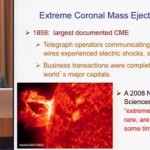Catching up on a development possibly missed during the holidays, the National Center for Supercomputing Applications (NCSA) last month announced that one of the more famous HPC systems of the past decade, the leadership-class Blue Waters supercomputer, is being decommissioned. Blue Water had its origins in 2007, when the National Science Foundation awarded $208 million […]
5 PhD Students Named New Frontiers Graduate Fellows
The New Frontiers Initiative, in collaboration with the Blue Waters Project at the University of Illinois at Urbana-Champaign, is pleased to announce the selection of the 2021 New Frontiers Graduate Fellows. The Graduate Fellowship program was launched in the fall of 2013 to provide PhD students with a year of support to advance their research. The program provides each […]
Applications Open for New Frontiers Initiative Graduate Research Fellowships
Grad students wanting to focus on their research have a new opportunity to do just that. The New Frontiers Initiative Graduate Fellowships provide PhD students with a year of full-time research support, including a $38,000 stipend, up to $12,000 in tuition allowance, and an allocation up to 100,000 node-hours on the powerful Blue Waters petascale […]
TACC’s Frontera Supports Investigation of Subatomic Protons – ‘the Origin of the Mass of Objects’
A team of researchers are using the Frontera supercomputer at the Texas Advanced Computing Center (TACC) to crack open the proton, a fundamental building block of the atomic nucleus that is used, among other ways, as a medical probe in magnetic resonance imaging. Frontera, the world’s fifth-ranked HPC system on the Top500 list and the […]
Simulations of Hydrogen Ingestion Flashes in Giant Stars
“My team at the University of Minnesota has been collaborating with the team of Falk Herwig at the University of Victoria to simulate brief events in the lives of stars that can greatly affect the heavy elements they synthesize in their interiors and subsequently expel into the interstellar medium. These events are caused by the ingestion of highly combustible hydrogen-rich fuel into the convection zone above a helium burning shell in the deeper interior. Although these events are brief, it can take millions of time steps to simulate the dynamics in sufficient detail to capture subtle aspects of the hydrogen ingestion. To address the computational challenge, we exploit modern multicore and many-core processors and also scale the simulations to run efficiently on over 13,000 nodes of NSF’s Blue Waters machine at NCSA.”
Seeking Students and Instructors for the Blue Waters Intro to HPC Virtual Course
The Blue Waters project at the University of Illinois is offering a new graduate course entitled Introduction to High Performance Computing. The course will be offered as a collaborative, online course for multiple participating institutions fall semester 2016. “The project is seeking university partners that are interested in offering the course for credit to their students. The course includes online video lectures, quizzes, and homework assignments with access to free accounts on the Blue Waters system.”
Apply now for HPC Summer School & Blue Waters Graduate Program
Application deadlines are fast approaching for the Blue Waters Graduate Program and the International Summer School on HPC Challenges in Computational Sciences.
Solar Superstorms Documentary Powered by Blue Waters
A new high-resolution science documentary about the dynamics of the Sun will feature data-driven supercomputer visualizations produced by NCSA. Narrated by Benedict Cumberbach, Solar Superstorms debuts June 30 at the Louisiana Art & Science Museum in Baton Rouge before heading out to more than a dozen planetariums and science centers around the world.
Simulating Geomagnetic Storm Effects on Power Grids
“Using Blue Waters, we are for the first time running highly detailed, global simulations of the Earth-ionosphere waveguide under the effect of a geomagnetic storm. Disturbed ionospheric currents are modeled in a three-dimensional Maxwell’s equations finite-difference time-domain (FDTD) model extending from -400 km to an altitude of 400 km.”
STAR-CCM+ Scales to 102,000 Cores on Blue Waters
NCSA recently announced a new world record by scaling CD-adapco’s flagship simulation tool STAR-CCM+ to 102,000 cores on the Blue Waters supercomputer.









